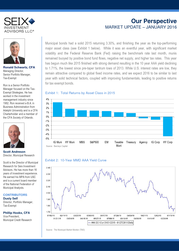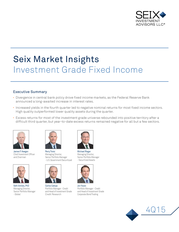Description
Barclays U.S. Aggregate Bond Index is an unmanaged index of U.S. bonds, which includes
reinvestment of any earnings and is widely used to measure the overall performance of the
U.S. bond market.
S&P 500 Index is an unmanaged index of 500 selected common large capitalization stocks
(most of which are listed on the New York Stock Exchange) that is often used as a measure of
the U.S.
stock market. Trade-Weighted U.S. Dollar Index is a measure of the value of the United States dollar relative to other world currencies. Investors can not invest directly in an index. A Basis Point is equal to 0.01%. Asset-Backed Security (ABS) is a financial security backed by a loan, lease or receivables against assets other than real estate and mortgage-backed securities. For investors, assetbacked securities are an alternative to investing in corporate debt. Commercial Mortgage-Backed Securities (CMBS) are a type of mortgage-backed security that is secured by the loan on a commercial property.
A CMBS can provide liquidity to real estate investors and to commercial lenders. Residential Mortgage-Backed Securities (RMBS) is a type of security whose cash flows come from residential debt such as mortgages, home-equity loans and subprime mortgages. This is a type of mortgage-backed security that focuses on residential instead of commercial debt. Yield Curve is a curve that shows the relationship between yields and maturity dates for a set of similar bonds, usually Treasuries, at any given point in time. Investment Risks: Bonds offer a relatively stable level of income, although bond prices will fluctuate providing the potential for principal gain or loss. Intermediate-term, higher-quality bonds generally offer less risk than longer-term bonds and a lower rate of return.
Generally, a fund’s fixed income securities will decrease in value if interest rates rise and vice versa. Mortgage-backed investments involve risk of loss due to prepayments and, like any bond, due to default. Because of the sensitivity of mortgage-related securities to changes in interest rates, a fund’s performance may be more volatile than if it did not hold these securities. U.S. Government guarantees apply only to the underlying securities of a fund’s portfolio and not a fund’s shares. The views expressed herein are as of the quarter-end specified.
This information is general in nature, provided as general guidance on the subject covered, and is not intended to be authoritative. It is subject to change without notice as market conditions change, and is not intended to predict the performance of any individual security, market sector, or RidgeWorth Fund. All information contained herein is believed to be correct, but accuracy cannot be guaranteed.
Investors are advised to consult with their investment professional about their specific financial needs and goals before making any investment decision. Past performance is not indicative of future results. ©2016 Seix Investment Advisors LLC. Seix Investment Advisors LLC is a registered investment adviser with the SEC and a member of the RidgeWorth Capital Management LLC network of investment firms. All third party marks are the property of their respective owners. RFRI-SEIXIG-1215 .
stock market. Trade-Weighted U.S. Dollar Index is a measure of the value of the United States dollar relative to other world currencies. Investors can not invest directly in an index. A Basis Point is equal to 0.01%. Asset-Backed Security (ABS) is a financial security backed by a loan, lease or receivables against assets other than real estate and mortgage-backed securities. For investors, assetbacked securities are an alternative to investing in corporate debt. Commercial Mortgage-Backed Securities (CMBS) are a type of mortgage-backed security that is secured by the loan on a commercial property.
A CMBS can provide liquidity to real estate investors and to commercial lenders. Residential Mortgage-Backed Securities (RMBS) is a type of security whose cash flows come from residential debt such as mortgages, home-equity loans and subprime mortgages. This is a type of mortgage-backed security that focuses on residential instead of commercial debt. Yield Curve is a curve that shows the relationship between yields and maturity dates for a set of similar bonds, usually Treasuries, at any given point in time. Investment Risks: Bonds offer a relatively stable level of income, although bond prices will fluctuate providing the potential for principal gain or loss. Intermediate-term, higher-quality bonds generally offer less risk than longer-term bonds and a lower rate of return.
Generally, a fund’s fixed income securities will decrease in value if interest rates rise and vice versa. Mortgage-backed investments involve risk of loss due to prepayments and, like any bond, due to default. Because of the sensitivity of mortgage-related securities to changes in interest rates, a fund’s performance may be more volatile than if it did not hold these securities. U.S. Government guarantees apply only to the underlying securities of a fund’s portfolio and not a fund’s shares. The views expressed herein are as of the quarter-end specified.
This information is general in nature, provided as general guidance on the subject covered, and is not intended to be authoritative. It is subject to change without notice as market conditions change, and is not intended to predict the performance of any individual security, market sector, or RidgeWorth Fund. All information contained herein is believed to be correct, but accuracy cannot be guaranteed.
Investors are advised to consult with their investment professional about their specific financial needs and goals before making any investment decision. Past performance is not indicative of future results. ©2016 Seix Investment Advisors LLC. Seix Investment Advisors LLC is a registered investment adviser with the SEC and a member of the RidgeWorth Capital Management LLC network of investment firms. All third party marks are the property of their respective owners. RFRI-SEIXIG-1215 .









